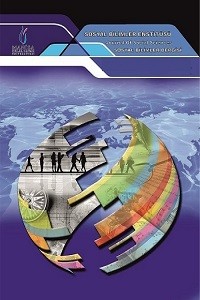DİSİPLİNLER ARASI BİR BİLİM DALI OLMA YOLUNDA YÖNETİM BİLİŞİM SİSTEMLERİ ve İŞLETME ENFORMATİĞİNİN TEMELLERİ
Öz
Son on yıldır bilişim toplumu içinde bilgi
sistemleri disiplinin özellikleri ve kimliğinin belirginliği hakkında yoğun bir
tartışma vardır. Yönetim Bilişim Sistemleri (YBS), İşletme Bilgi Yönetimi ve
İşletme Enformatiği (İE) gibi isimler altında gün geçtikçe çoğalan bölümler enformasyon
toplumunun değişen dinamikleri ve ihtiyaçları doğrultusunda yenilenmeye ve
gelişime yön verebilecek iş gücü yaratmak amacıyla kurulan bölümlerdir. Bununla
birlikte Yönetim Bilişim Sistemleri ve İşletme Enformatiği mezunlarının temel
becerileri ve yetenekleri üzerine de bir tartışma halen devam emektedir. Bilişim
sistemlerinin yazında çok sayıda sınıflandırılması yapıldığı görülmektedir. Bu
çalışmada Yönetim Bilişim Sistemleri ile İşletme Enformatiği disiplinlerinin
benzerlikleri ve farklılıkları belirlenmiştir. İlgili uluslararası ve ulusal
yazın taranarak kavramsal bir içerik oluşturulmuş olup, bu çalışmadan elde
edilen sonuçlar hem akademik alanda hem de uygulama yazınından elde edilen
bilgilere dayanmaktadır. Sonuç olarak her iki çalışma alanının aralarında çok
sayıda benzerlik olsa da İşletme Enformatiğinin daha genele odaklanması ve
kapsayıcı olması nedeniyle bir disiplin olarak kabul edildiği söylenebilir.
Anahtar Kelimeler
Bilişim Sistemleri Yönetim Bilişim Sistemleri İşletme Enformatiği Enformatik
Kaynakça
- Adeoti-Adekeye. (1997). The importance of management information systems. MCB Bank. Library Review, 46 (5), 318-327. Alter, S. (2003). Sidestepping the IT artifact, scrapping the IS silo, and laying claim to ‘Systems in Organizations. Communications of the AIS, 12(30), 494-526.Baskerville, R.L. ve Myers, M.D., (2002), Information systems as a reference discipline. MIS Quarterly, 26(1), 1-14. Becta (2005). School Management Information Systems and Value for Money. Coventry: Becta. [Online] Available: http://www.egovmonitor.com/reports/rep12009.pdf . Accessed on 23rd February 2018. Benbasat, I., ve Zmud, R. (2003). The identity crisis within the IS discipline: Defining and communicating the discipline core properties. MIS Quarterly, 27(2), 183-194. Burt, E. ve Taylor, J. A. (2003). Information and Communication Technologies: Reshaping Voluntary Organizations?, Nonprofit Management and Leadership, 11(2), 131-143.Davis, G. B. ve Olson, M. H. (1985). Management Information Systems: Conceptual foundations, structure, and development,. New York: McGraw-HillDobay, P. (2006). Vállalati információmenedzsment (Corporate information management), Nemzeti Tankönyvkiadó, Budapest, Ferstl, O. K., ve Sinz, E. J. (2001). Grundlagen der wirtschaftsinformatik [Fundamentals of business informatics] (4th ed.). München, Wien: Oldenbourg. Helfert, M. (2010). Characteristics of Information Systems and Business Informatics Study Programs, Informatics in Education, 10 (1), 13-36Kemper, H. ve G., Stelzer D. (1990). Wirtschaftsinformatik als Studiengang an Hochschulen in der Bundesrepublik Deutschland, Österreich und der Schweiz - Ergebnisse einer Erhebung an zwölf Hochschulen im November 1989. //Wirtschaftsinformatik. 1: 49-56.Kozak, S. (2005). The role of information technology in the profit and cost efficiency improvements of the banking sector. Journal of Academy of Business and Economics, February 2005. Kryt, Jacek ve Paliwoda, Stanley J., (1992). Management Information Systems in Poland and in the West, Marketing Intelligence & Planning, Vol. 10 Issue: 6, pp.37-44Laudon, K.C. ve Laudon, J.P. (2003). Management Information Systems: Managing the Digital Firm (Upper Saddle River, NJ: Prentice Hall). Lee, A.S., (2001), Editorial. MIS Quarterly, 25(1), iii-vii. Markov, Kr., Ivanova, Kr. ve Mitov, I. (2006). Basic Structure of the General Information Theory. IJ ITA, 14(1), 5-19Mertens, P., ve Barbian, D. (2002). Zur situation der wirtschaftsinformatik im lichte des studienführers [The situation of business informatics in the view of the study guide]. Wirtschaftsinformatik, 44(5). 502-505.O’Brien, J. (1999). Management Information Systems-Managing Information Technology in the Internetworked Enterprise, Boston: Irwin McGrawHill, Obi, Emenike. (2003). Educational Management: Theory and Practice. Enugu: JAMOE Nigeria Enterprises. O'Neill, B.S., ve Adya, M. (2007). Knowledge sharing and the psychological contract: Managing knowledge workers across different stages of employment, Journal of Managerial Psychology, 22 (1), 411-436. Orlikowski, W.J., ve Iacono, C.S. (2001). Desperately Seeking The "IT" In IT Research - a Call to Theorizing the IT Artifact, Information Systems Research (12:2), June, pp. 121-134. Pour, J., Voříšek, J., Feuerlicht, G. (2013). Model for management of enterprise IT: considerations of the impact of Cloud computing. In: Confenis. Linz: Trauner Verlag, pp. 157-168. ISBN 978-3-99033081-4.Raffai, M. (2003). Információrendszerek fejlesztése és menedzselése (Development and management of information systems). Novadat Kiadó, Retzer, S., Fisher, J., ve Lamp, J. (2003). Information systems and business informatics: An Australian German comparison. Proceedings of the 14th Australian Conference on Information Systems. Sasvari, P. ve Majoros, Z. (2013). Comparison of the Information Technology Development in Slovakia and Hungary, International Journal of Advanced Computer Science and Applications, 4 (2).Shaw, R. (1991). Computer Aided Marketing and Selling, Rbhp Trade Group, ISBN 978-0750617079, Shu, W. ve Strassmann, P.A. (2005). Does information technology provide banks with profit?. Information & Management, 42(5), 781-787. Skyrius, Rimvydas. (2001). Business Decision Making, Managerial Learning and Information, Bank of Vilnius, Luthuania. [Online] Available: http://ecommerce.lebow.drexel.edu/eli/pdf/skyriusEBKBusin.pdf Accessed on 22nd February 2018.Topi, H., Valacich, J., Kaiser, K., Nunamaker, J., Sipior, J., Vreede, G., ve Wright, R. (2007). Revisiting the IS model curriculum: Rethinking the approach and the process. Communications of the Association for Information Systems, 20(11), 728-740Voříšek, J., Pour, J., Buchalcevová, A. (2015). Management of Business Informatics Model - Principles and Practices, Information Management, 18 (3), DOI: 10.15240/tul/001/2015-3-014Žák, M., ve diğerleri (2013). Konkurenční schopnost České republiky 2011-2012. Praha: Linde, ISBN 978-80-7201-910-6.
Ayrıntılar
| Birincil Dil | Türkçe |
|---|---|
| Bölüm | İktisadi ve idari Bilimler Sayısı |
| Yazarlar | |
| Yayımlanma Tarihi | 30 Haziran 2019 |
| Yayımlandığı Sayı | Yıl 2019 Cilt: 17 Sayı: 2 |


